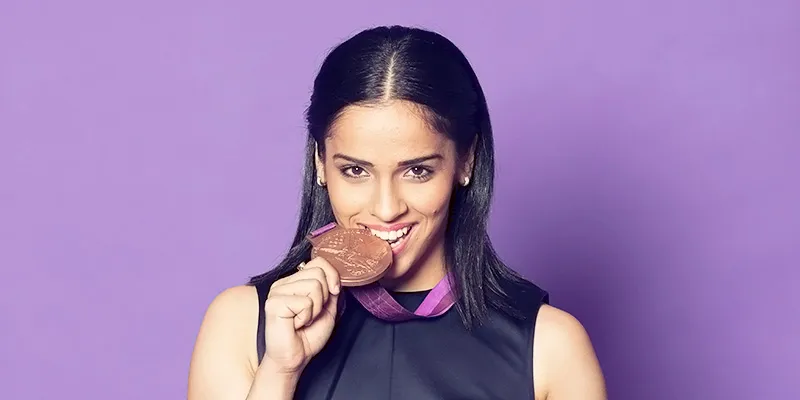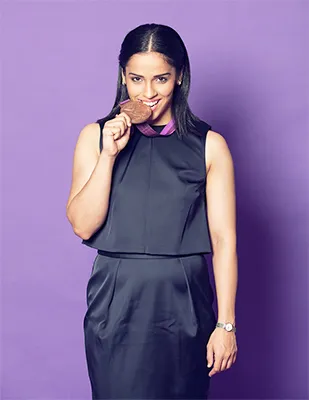World No.1 Saina Nehwal nearly gave up but says persistence pays
After becoming the World number one, ace badminton player Saina Nehwal must have treated herself to aloo parathas and ice creams. “After a point, when you are playing, you realise that you can’t eat junk food because it just ends up weighing you down and leaving you exhausted. So I steer away from it, and focus on a balanced meal. I give myself permission to cheat occasionally only, such as when I have notched up a victory. I will then indulge with an aloo paratha, ice cream or a milkshake. From the next day, it’s back to discipline,” she tells ‘Smart Life’ magazine.
“When I joined the sport, I never thought of becoming World number one. It was only my mom’s dream. But after achieving it, I am really very happy. And I feel lucky to become the first women shuttler to be no. 1 after Prakash Sir, who is a legend. I will rate this after the Olympic medal,” she told PTI after her recent win, adding,
I have taken some many hard decisions to get here. I kept losing to the top players all the time, in fact after last year’s World Championship I even thought of quitting badminton. It was a very dark time in my career. People were saying ‘Saina your career is finished.’

Such is her dedication and passion for the game that in the weeks before she left for the Olympics in London in 2012, Saina was down with a fever. “My body was hurting and I was running a temperature. My parents were upset. I felt completely dejected and thought that I wouldn’t be able to compete. I cried a lot, thinking that all the hard work that I had put into my game would come to nothing,” recounts Saina.
That she competed and won a bronze medal, the first by any Indian in the game, is a testament to the athlete’s grit and determination. She acknowledges that she “showed courage and fought the battle well,” but not before giving the credit to Lady Luck for everything she has achieved in life.
Such modesty is unexpected in an athlete of her stature. After a year of dogged pursuit to pin this ace athlete down for a photoshoot for Smart Life magazine cover, she enters the studio dressed in jeans and a casual sweater (thanks to Hyderabad’s chilly winds) in February, and wins many a hearts instantly. From the light boys to the owner of the gift shop downstairs, who hopes that Saina will find the time to visit her little store (she does, and ends up buying some knick knacks), everyone wants a selfie with her. The Olympian obliges them all, even urging everyone to come in for one large group photo at the end of the shoot.
A lot of it is probably because she chooses to surround herself with family. For instance, she arrives for the shoot with her mother, sister and niece and not a retinue of sundry yes men like most other celebrities. As the shoot progresses, her family does not fuss around her and leaves Saina to do her job. Saina, on her part, behaves like a normal 20-something — curious about the clothes she is expected to wear for the shoot or how the photographs are turning out to be — and is unmindful of what a big star she actually is.
There is, however, no denying she is exceptionally busy. “I’m here at home now for a week, and this is the only time I get to rest,” she says, “Also, I’ve been lucky to get a lot of people to back me, and give me endorsement deals, so I’m managing those commitments too right now.” In fact, she had landed in Hyderabad only the previous night from an event in Thiruvananthapuram. But she admits she enjoys the media interactions and the shoots; something different from the “usual round of training.”
Training days
Saina’s earliest athletic pursuit was swimming, before she switched to badminton full time, but she doesn’t get much time in the pool now. All her time and energy is focused on perfecting her game and building her strength and fitness. “I spend about three and a half hours training on court in the mornings. I practice all aspects of the game, and it’s quite rigorous, with rallies lasting up to 45 minutes to an hour,” she says. The evenings are spent in off-court training. “A lot of running, different forms of endurance training, agility exercises,” she says, adding, “My trainers decide what I will do on a day to day basis. So one day, it might be strength training, where I’ll work on my core or legs or arms, and the next day, it could be interval training.” Her strong, toned limbs are a testament to the amount of work she puts in. She says, “Strength training is really important if I want to be injury free. I focus on not just the big muscles, but also the small muscles. It’s a mistake to believe that only the big muscles count. For example, when you hit a smash, it’s not just your shoulder muscles that are working, your forearms and wrist are also putting in a lot of work.”
Read more- Rapid Fire with Saina Nehwal in 2013
Discipline is a key factor in ensuring that such a rigorous training schedule is followed. It is also a key factor in maintaining a diet that provides the optimum nutrition. Saina confesses that she puts on weight very easily and so has to be especially careful about what she eats. “After a point, when you are playing, you realise that you can’t eat junk food because it just ends up weighing you down and leaving you exhausted. So I steer away from it, and focus on a balanced meal. I give myself permission to cheat occasionally only, such as when I have notched up a victory. I will then indulge, with an aloo paratha, ice cream or a milkshake. From the next day, it’s back to discipline.”
True grit
Saina talks about the game in a rapid-fire delivery, recounting matches in perfect chronological order. Her rather cinematic narration has luck as a recurring motif. “I was on antibiotics and was feeling very tired. But I had worked so hard to reach there; I couldn’t go down without a fight. My opponent (China’s Wang Xin) and I were playing a long rally of almost 30-32 strokes, when I suddenly saw her go down. She had a long discussion with her coach and physio and finally, I see her going off the court. She was injured and had decided to retire from the match. There again, I had good luck,” she says, of the historic Olympic match.
Not that ‘luck’ has always held her in good stead. The very next year, 2013, saw her plummet in the

rankings. Injuries dogged her; a toe fracture required six weeks to heal, which is rather long in an athlete’s training. “That year was torture. I was repeatedly being beaten by the top three players, and I didn’t win any titles,” she says.Taking a hard look at what her game required and working towards it helped Saina regain her form. She says, “In most other countries, when a player reaches a certain level, they start to get personal attention. In India, this system does not exist. But I felt like I needed to change the way I was training, because I hadn’t been doing anything differently. I needed personal attention now and both my coach and I needed to not only analyse my game, but also that of my opponents.”
This realisation prompted her to move from Pullela Gopichand’s tutelage in Hyderabad to Bangalore, where she started training under Vimal Kumar. The move generated much speculation about her equation with her former coach, but Saina maintains that their relations were perfectly cordial and that ‘Gopi sir’ understood her reasons for the move.
Looking ahead
Saina showed her mettle in 2014 by soaring from rank nine to rank four by the end of the year. She says that she has set herself some goals for this year too, but she would rather keep them to herself. “Of course, I want to keep doing better and improve my training and win titles. I want to be injury free and beat the Chinese players, who are among the best in the world. But certain goals, I would like to keep to myself.”
Does this betray a streak of superstition, one that most top sportspersons from Sachin Tendulkar to Serena Williams and Michael Jordan have? Saina makes it clear that some things are only for her to know. She explains, “If I say these things out loud and fail to live up, it gives people the opportunity to say things about me.” This wariness in her is understandable considering she is celebrated in a nation that reviles its public figures just as much as it adores them. The recent furore over her remarks about being denied a Padma Bhushan (and then being recommended for it) is a case in point. Ask her about it and she politely declines to comment.
For now, Saina wants to focus on her game. She says that she has been fielding questions about her future in the game and marriage plans ever since she turned 20. As a celebrity, she understands it is par for the course, and does not resent it. Instead, she expresses gratitude for being given the opportunity to do what she does. “I have everything because of my game, even the endorsement deals. So ultimately, my main focus should remain the game and I should not get diverted into other issues. When I train, I train really hard because that is what really matters.”
Highlights of her career
Saina takes over the reins from China’s Li Xuerui, thereby ending the Chinese stranglehold over the world rankings for many years. The London Olympic bronze-medallist has won a staggering 14 international titles in her glorious career and most recently became the first Indian woman to make the finals of the prestigious All England Championships in Manchester.
Indonesia Open, 2009, 2010, 2012 – “There’s something so great about playing in Indonesia. The crowd is always great and they’re rooting for someone other than the Chinese to win.”
Bronze at the 2012 London Olympics – “Ever since I was a child, my mother had wanted me to become an Olympic medalist.”
China Open Super Series in 2014 – “Beating the Chinese in front of their home crowd is a special high, since the Chinese have dominated the game for so long.”
YourStory in association with ‘SmartLife’ magazine brings an interaction with World #1 Saina Nehwal. Smart Life magazine is a health and fitness magazine.
(image credit- Smart Life magazine)







